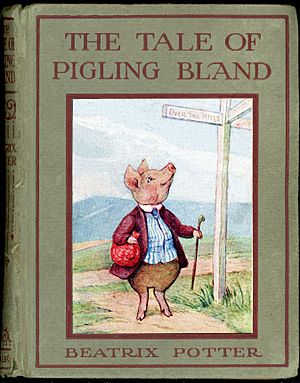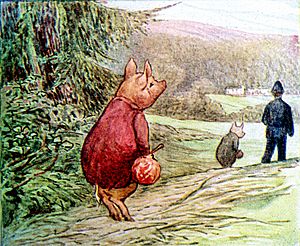The Tale of Pigling Bland facts for kids

First edition cover
|
|
| Author | Beatrix Potter |
|---|---|
| Illustrator | Beatrix Potter |
| Country | England |
| Language | English |
| Genre | Children's literature |
| Publisher | Frederick Warne & Co |
|
Publication date
|
1913 |
| Media type | Print (hardcover) |
| Preceded by | The Tale of Mr. Tod |
| Followed by | Appley Dapply's Nursery Rhymes |
The Tale of Pigling Bland is a fun children's book written and drawn by Beatrix Potter. It was first published in 1913 by Frederick Warne & Co. The story is all about the adventures of a little pig named Pigling Bland and how his life changes when he meets a special friend.
Contents
What's the Story About?
Pigling Bland's Journey Begins
The story starts with Aunt Pettitoes, an old sow who has eight playful piglets. She can't manage them all, so she sends most of them away from home. Only one well-behaved piglet named Spot gets to stay.
Two of the piglets, Pigling Bland and his brother Alexander, are boars (male pigs). They are sent off to the market. Pigling Bland is very sensible, but Alexander is a bit more careless. Alexander loses his pig license! When a policeman asks to see it, Alexander can't find it and has to go back to the farm.
Getting Lost and Making a Friend
Pigling Bland has to go on alone, even though he doesn't want to. Later, he finds the missing papers in his own pocket! They must have fallen there during a playful struggle with Alexander earlier. He tries to find his brother but gets lost in the woods instead. He ends up spending the night in a stranger's chicken coop.
The next morning, a grumpy farmer named Peter Thomas Piperson finds him. The farmer lets Pigling Bland stay in his house, but Pigling isn't sure if he can trust the farmer.
His worries quickly come true. He finds out that Piperson has another pig in his house. This pig, a beautiful black Berkshire sow named Pig-wig, was stolen from her owner. The farmer plans to turn both pigs into bacon and ham!
An Escape to Freedom
Pig-wig suggests they run away so they won't be sold or, even worse, eaten. Pigling Bland has already decided he doesn't want to go to the market anymore. He dreams of becoming a potato farmer instead.
At dawn, the two pigs quietly sneak away. As they escape, they meet a grocer in a cart. The grocer recognizes Pig-wig as the stolen pig and knows there's a reward for her return.
Pigling Bland and Pig-wig act cleverly. They cooperate with the grocer, and Pigling Bland even pretends to have a limp. This buys them time. Once the grocer is far enough away, they run to the county border. Finally, they escape over the hills and far away! There, they dance to celebrate their new freedom together.
Where Did the Idea Come From?
Beatrix Potter's Farm Life
Beatrix Potter owned a farm called Hill Top. She bought this farm because her early books were so successful. The farm and its house appeared in many of her stories. She even had pigs there!
In a letter from 1909, Beatrix Potter wrote to her friend Millie Warne about selling two of her pigs. She said their "appetites were fearful – five meals a day and not satisfied." She started working on The Tale of Pigling Bland around this time.
The Real Pig-wig
The character Pig-wig was inspired by a real Berkshire pig that Beatrix Potter bought from a farmer named Townley. John Cannon, who managed Potter's farm, didn't want a black pig there. So, Potter kept Pig-wig as a pet. She described her as "very friendly" and said she "likes being tickled under the chin."
Beatrix Potter dedicated the story to Townley's children. She wrote: "For Cecily and Charlie. A Tale of The Christmas Pig."
A Story About New Beginnings
The story was finished and published in 1913. That year was very busy for Beatrix Potter. She dealt with illness, planned her wedding to William Heelis, and moved to a bigger house called Castle Cottage. Some people think the story's theme of a couple starting a new life together reflected what was happening in Potter's own life.
How Was the Book Made?
Drawing the World of Pigling Bland
Many of the places and landscapes in the story are based on the real Lake District in England. One drawing shows Pigling Bland and Pig-wig, arm in arm, watching the sun rise over a part of Westmorland.
Beatrix Potter even included herself in the illustrations and as the narrator. She described herself disciplining two of Pigling Bland's sisters. In a letter, she mentioned sketching a pig in a pig sty. She said the pig tried "to nibble my boots, which is interrupting."
A local man with his horse and cart posed for a photo. Beatrix Potter used this photo to create a colorful drawing of the pigs meeting the grocer. The signpost shown on the front cover of the book is a copy of a real one near Beatrix Potter’s farm.
Other Ways to Enjoy the Story
Movies, Shows, and Plays
- In 1971, the story became a part of The Royal Ballet film, The Tales of Beatrix Potter.
- In 1994, an animated movie version was shown on the BBC television series The World of Peter Rabbit and Friends. Pam Ferris voiced Aunt Pettitoes, and Josie Lawrence was the voice of Pig-wig.
- The Tale of Pigling Bland was first performed as a musical play on July 6, 2006. This happened at the Toronto Fringe Festival in Toronto, Ontario, Canada.
- A radio play of The Tale of Pigling Bland was broadcast on BBC Radio 4 on December 23, 2013. It was part of the 15-minute Drama series. Johnny Vegas voiced Pigling Bland, and Morwenna Banks was Alexander.
- Pigling Bland also appears in the 2018 animated and live-action movie Peter Rabbit. He was voiced by Ewen Leslie.


